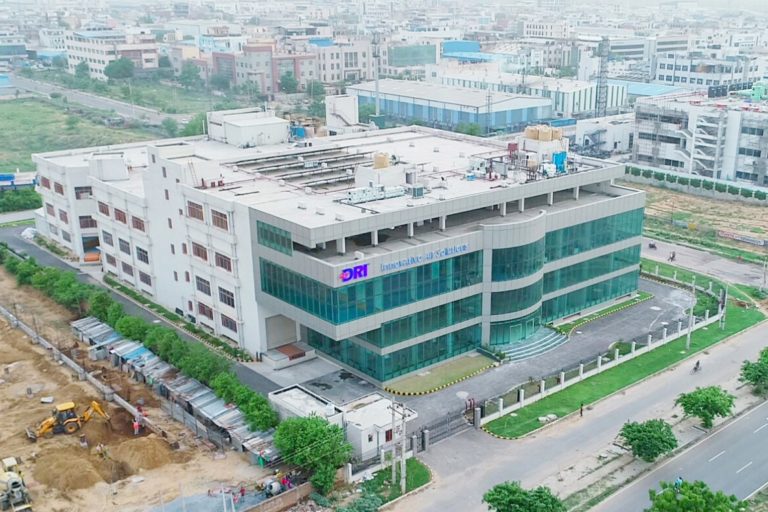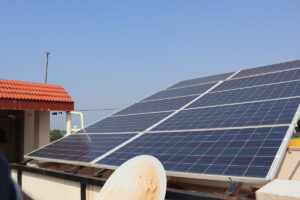Net-Zero Buildings See A Rise But Lack Govt Guidelines, Regulations
Mar 1, 2023 | Pratirodh Bureau
The net-zero DRI building in Manesar, Haryana. Net-zero buildings use solar or any other renewable energy sources to offset their annual energy requirements (Image: DRI)
Badriya Juma Masjid is a mosque at Kundapur in Udupi district in Karnataka spread over an area of 15,000 square feet. Unlike other popular mosque designs, this religious building has a different look. The L-shaped mosque has a wind turbine at the top of its building and solar panels on the rooftop. This is one of the selected net-zero energy buildings in India, rated by the Indian Green Building Council (IGBC), last year.
“Since the design phase, we started to construct it in a way that can reduce our energy requirements. We ensured taking all measures to increase our energy efficiencies like ensuring adequate daylight enters the building, using building materials that helped in adequate insulation of the walls and roofs,” Syed Mohammad Beary, founder of Beary Groups who built the mosque, told Mongabay-India.
The earlier assessed total energy requirement of the building was estimated to be around 25 KwH (Kilowatt-hour), but Beary said that with energy efficient measures, it was reduced to 7.5 KwH which is now catered with its solar rooftop (6 KwH) and wind turbine (1.5 KwH).
Meanwhile, in the north of the country, in Manesar in Haryana, close to New Delhi, the manufacturing plant building of Desiccant Rotors International is another example of a net-zero energy building. The firm manufacturing unit produces heat-recovering units, used in air conditioning. The building is spread in 200,000 sq. ft area and was constructed in 2019 and soon the features of net-zero energy buildings were imbibed.
“We have a connected load demand of 50 KW and we also have a solar system that generates this amount of energy. We have designed the building in such a way that the requirement of electricity during daytime is reduced and with more energy efficient measures we reduced the total load of the building,” Rahul Aeron, Vice President (Sales) from the firm told Mongabay-India.
There are several other net-zero buildings in India. Some of them include the Paryavaran Bhavan of the Ministry of Environment and Forests, Jaquar headquarters in Manesar, Akshay Urja Bhavan in Haryana, Godrej Plant 13 Annexe in Mumbai, Grid Corporation of Odisha building, among others.
Architects and sustainable building experts from the country claim that there is no clear definition of “net-zero building” in government rulebooks. They said that in real estate parlance, net zero energy buildings refer to such buildings which are producing the same amount of non-fossil fuel energy that they consume from the grid annually. However, private rating agencies have stricter norms for net-zero buildings where energy efficiency designs are also taken into account.
“There is no clear definition of net-zero buildings in India from the government side. There are several concepts of net-zero buildings. It could be net-zero carbon building, net-zero water building, and net-zero waste building. But usually in the building ecosystem, in general terms, net-zero refers to net-zero energy buildings where the total amount of energy required in the building is compensated by the total amount of electricity produced by renewable sources of energy,” Rishabh Jain, an architect specialising in sustainable buildings told Mongabay-India.
Ratings And Norms For Net-Zero Energy Buildings
Currently, there is a dearth of any government guidelines, building codes and regulations on net-zero buildings in India. The Model Building Codes of 2016 deal with the concept of ‘Sustainable and Green Buildings’. The Code mandates that buildings spread in areas beyond 100 square meters, should have provision for solar energy, solar water heater, and other green building norms like rainwater harvesting, energy efficiency, and others. But it does not talk about net-zero buildings.
The Energy Conservation Building Code of 2017, released by the Bureau of Energy Standards (BEE) makes it mandatory for commercial buildings with connected loads with more than 100 KwH to make provision for reserving a minimum of at least 25 percent of roof area for renewable energy and ensuring one percent of their peak demand from renewable energy. It also talks about making passive design strategies in designing buildings which can increase the energy efficiency of such buildings.
The Ministry of Power in 2021 also started rating net-zero buildings with its Shunya scheme where the BEE gives certification of net-zero buildings. This is given if the buildings can offset their building energy requirements with renewable energy. Buildings producing renewable energy equivalent to their total consumption get a Shunya (net-zero) label whereas those producing more renewable energy than their connected load get a Shunya Plus rating from BEE. The documents of BEE certification for net-zero do not account for energy efficiency while granting net-zero rating certifications.
The BEE, which rates net-zero buildings, defines such buildings as “…that relies on renewable sources to produce as much energy as it uses, usually as measured over the course of a year.” It does not take into account energy efficiency, building design, thermal comfort and other architectural parameters as accounted by other rating agencies like IGBC.
BEE claims it has around 100 rating certifications under different stages of consideration for net zero buildings. Emails sent by Mongabay-India to BEE for more comments on the issue didn’t evoke any response till the time of writing the report.
IGBC Ratings For Net-Zero Building
The Indian Green Building Council (IGBC), a part of the Confederation of Indian Industry (CII) which was earlier known for rating Green Buildings in the country, started rating “net zero ” buildings in 2018. The IGBC rating, which is intent oriented and voluntary in nature, rates net zero buildings based on their usage of renewable energy, energy efficiency, passive design strategies, and thermal comfort (comfortable room temperature). It gives merely 25 percent weightage to the use of renewable energy and focuses more on energy-efficient designs and other architectural parameters.
However, neither the BEE rating nor the IGBC rating of net zero buildings take into account the requirement of energy utilised during the construction phase of these buildings where there is use of cement, machines, transportation, electricity, among others. This is called embodied energy of the building.
Experts in the academia said that embodied energy should also be a part of calculation when buildings are declared as net-zero. “The current practices of intent-based green building rating programs do not serve the purpose at the same time – in fact, it largely leads to greenwashing, net zero energy building should be called only based on its measured performance for the operational and embodied energy,” Rajan Rawal, Professor, Building Energy Performance at CEPT University, Ahmedabad, told Mongabay-India. The university operates a science laboratory building as a net zero energy building since 2016.
“Renewable energy can be used during the construction stage of a project to offset the associated carbon with construction power. However, this construction power is a very small component. At the construction stage, the biggest challenge is embodied carbon. After a building is completed, operational carbon comes into picture. That is when net zero energy buildings come into picture wherein operational energy is through renewables,” Rakheja added.
Advantages Of Net-Zero Building Certifications
Saswati Chetia is an architect and Associate Director at Greentech Knowledge Solutions Pvt. Ltd in New Delhi. She said that certifications and ratings in the real estate sector often help in adding more trust of the consumers as well as the government.
“You take the example of Green Building ratings. It helped the market to grow. Such a certification adds trust for buyers if they are governed by compliance of established and tested parameters. Although we do not find an institutionalised central policy for incentives as of now for net zero buildings, the ratings help in getting exemptions in local taxes or in some relaxation in floor area ceiling which green buildings in some areas of the country receive,” she said.
She also added that the consistent usage of renewable energy in such buildings can help in reducing the overall cost of operation of such buildings in their life cycles. Chetia said that even in high-rise buildings where there is a dearth of space for installing on-site renewable energy sources, off-site renewable energy systems can also be wheeled to get net-zero status or consumers can opt for only renewable energy through their grid supply via open access.

According to BEE, around 30 percent of total power in India is consumed by buildings alone. It also claims that it is also the second largest greenhouse gas emitter sector after industries. The demand for power in the country is also rising with time.
Experts claimed that with support of the governments at the federal and state level, the industry. which is at its nascent stage, can see more growth. Deepa Parekh, a Mumbai-based net-zero building consultant told Mongabay-India if there is more awareness in the industry and incentives from the government on net-zero building, the concept could get more pace in the market.
“Today, several corporate houses are declaring their net zero targets and ensuring net zero buildings are often part of such strategies. While net-zero buildings are slowly picking up in the market, it is not mainstream yet. While it will take time to fully develop, the concept of net zero buildings is practically achievable,” she said.
She added, “The green building rating systems such LEED Zero and IGBC Net Zero evaluate net zero buildings based on their performance when they are operational. Renewable energy technologies often get the spotlight to achieve the net zero equation. However, for a sustainable building sector, the focus should be on reducing the demand for energy during both design and construction phase of buildings.”
Several countries are, meanwhile, working to decarbonise the building sector with regulations. In a latest move, the Denmark government has made it mandatory for all new buildings more than 1000 square-meters to make life cycle assessment of their building for 50 years and limit their carbon dioxide emissions upto 12 kilogram per square-meter of area per year.
While in net-zero buildings ratings, the embodied emissions and energy of buildings are not calculated but the Green Rating for Integrated Habitat Assessment (GRIHA), another Indian building rating agency, endorsed by the Ministry of New and Renewable Energy in their rating of building takes into account the different stages of construction. It includes scrutiny of its design, procurement and implementation. GRIHA also does lifetime assessment of buildings considering different stages.
(Published under Creative Commons from Mongabay-India. Read the original article here)
